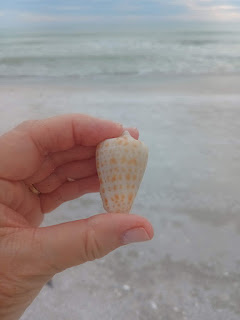The Alphabet Cone

Alphabet Cone The Alphabet Cone is one of my personal favorites. It's fairly rare, but not as rare as the mighty Junonia. The one in the photo came rolling in with a wave. You have to be quick when that happens. But when you make the capture, it's magical. Unlike the Junonia which lies deep in the ocean, the Alphabet Cone (Conus spurius) is typically found in shallow coastal water and also in sandy or muddy substrates near the shore. It gets its name from the markings on the outside of the cone that resemble letters of the alphabet and punctuation marks. The colors range from yellow to dark brown. They have a hearty shell with a narrow opening. The ones that I've found have all been intact, which is always a treat. Since they are not deep sea dwellers and prefer the shallow waters of the coastal area so they can find their prey, you need to exercise caution. They kill their prey by using a venomous harpoon-like tooth, which paralyzes them first. Their preferred prey a...
